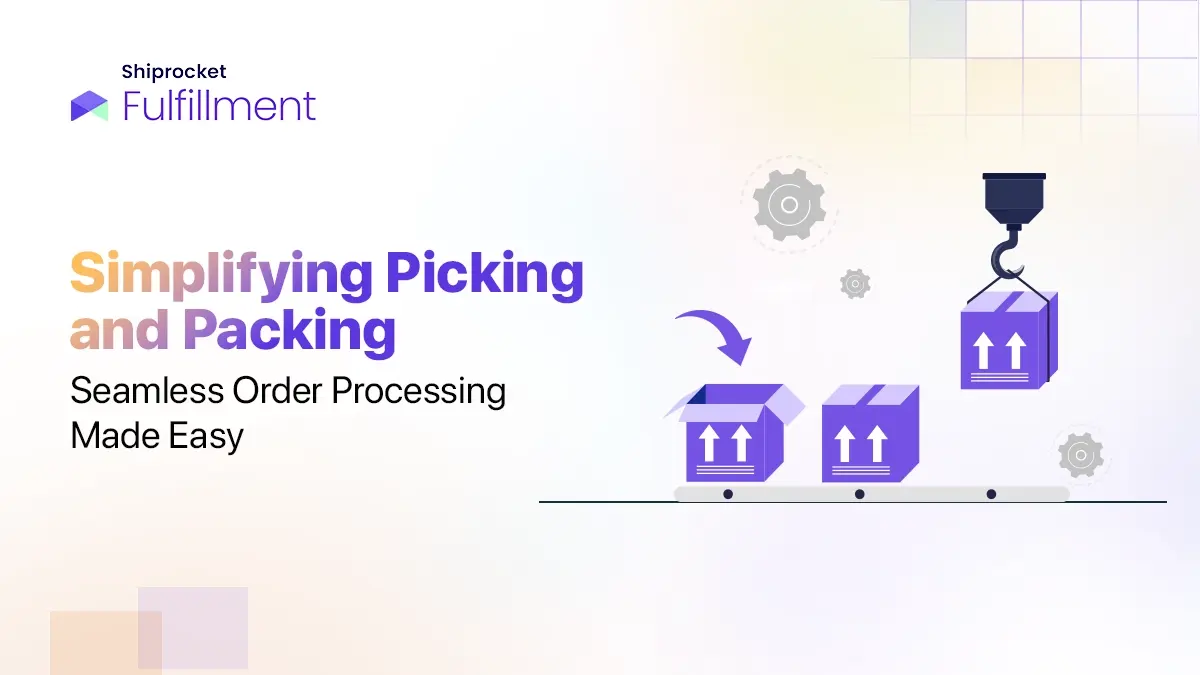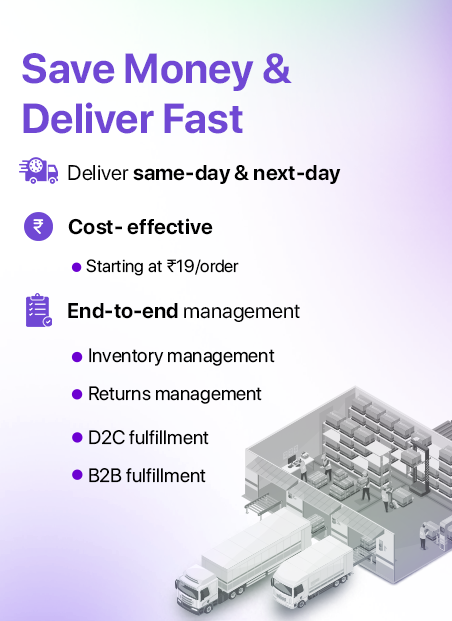- Exploring the Concept of Warehousing
- Key Components of Warehousing Logistics
- Interconnection between Warehousing and Supply Chains
- Solutions for Logistics and Supply Chain Challenges
- Selecting the Ideal Warehousing Solution
- Implementing a Warehouse Management System for Self-Managed Warehouses
- Conclusion
- Frequently Asked Questions(FAQs)
In the eCommerce industry, warehousing and fulfillment centers have become crucial stages of the logistics cycle. Today, modern warehousing relies on technology-driven automation, simplifying storage, retrieval, picking, and labelling of products for delivery. This definitive handbook on warehousing will guide you through leveraging inbound and outbound logistics to effortlessly run your eCommerce business.

Exploring the Concept of Warehousing
The core concept of warehousing is the safekeeping and managing of goods during their transit from the point of production to the eventual distribution to customers. Therefore it is a very crucial stage where storage plays a pivotal role in bridging the gap between production and consumption.
A logical way for small and emerging businesses to explore warehousing solutions is to outsource logistics to third parties and manage their inventory from such facilities.
For larger eCommerce businesses, the warehousing process differs slightly. In these cases, products are stored in inventory within dedicated facilities until an online order is placed. Once the order is received, the products are shipped directly to consumers from the warehouse. However, modern warehouses go beyond just storage; they have become dynamic hubs that offer various value-added services. These services include order fulfillment, packaging, and quality control.
Key Components of Warehousing Logistics
Any business that sells physical goods needs to manage the movement of goods from makers to consumers. Here are some of the key elements of warehousing logistics for the eCommerce industry-
- Receiving and Unloading: This initial stage of warehousing logistics involves receiving incoming goods from suppliers or manufacturers. It is crucial to manage this process efficiently to ensure smooth workflow within the warehouse. During this stage, the following activities are carried out:
- Warehouse Management: The day-to-day operations are planned and executed to achieve an optimised workflow. This includes establishing processes, setting up workstations, and defining roles and responsibilities for the warehouse staff.
- Inventory Management: Incoming goods are carefully counted, inspected, and recorded to update the inventory. This ensures that the system reflects accurate stock levels and prevents discrepancies between actual stock and recorded stock.
- Safety Measures: Safety protocols are strictly followed during unloading to prevent accidents or damages. Proper equipment and training are provided to the staff to handle goods safely.
- Security Measures: To safeguard the inventory from theft or unauthorised access, a security perimeter is established. Access controls, surveillance systems, and other security measures are put in place.
- Tracking and Inventory Management: This component involves the continuous monitoring and management of inventory within the warehouse. The goal is to ensure that the right products are available when needed and that storage space is optimised. The following activities are part of this stage:
- SKU Implementation: Each product is assigned a unique Stock Keeping Unit (SKU) to facilitate easy identification and tracking. SKUs are used in inventory systems to monitor the movement of products.
- Dedicated Storage: Items are placed in designated locations within the warehouse to enhance efficiency. This organised storage approach helps save time when picking products for orders.
- Inventory Tracking: As products move in and out of the warehouse, their status is updated in the inventory management system. Real-time tracking allows for better control over stock levels and timely replenishment.
- Order Fulfillment and Prepping: This stage focuses on fulfilling customer orders accurately and efficiently. It involves picking the ordered items from their respective storage locations and preparing them for shipment. Key activities include:
- Order Prioritisation: Orders are prioritised based on their urgency and shipping requirements. High-priority orders may be processed and shipped first.
- Picking: Warehouse staff retrieves the products from their designated storage areas according to the order details. Efficient picking strategies, such as zone picking or batch picking, are employed to streamline the process.
- Sequencing: The picked items are organised and sequenced for packing and shipping. This minimises errors and ensures that the correct items are packed together.
- Packaging and Labeling: Once the ordered items are picked and assembled, they need to be properly packaged and labelled to ensure safe and accurate delivery to customers. This stage includes:
- Packaging: Suitable packaging materials, such as boxes, bubble wrap, or cushioning, are used to protect the products during transportation.
- Labelling: Each package is labelled with the necessary shipping and tracking information, including the recipient’s address, shipping method, and tracking number.
- Shipping and Dispatch: The final stage of the warehousing logistics process involves shipping the prepared orders to customers. This includes:
- Shipping Arrangements: The appropriate shipping method and carrier are selected based on customer preferences, delivery timelines, and cost considerations.
- Dispatch: The packaged and labelled orders are handed over to the chosen carrier for delivery to customers.
Interconnection between Warehousing and Supply Chains
After completing the warehousing process, the order is now ready for dispatch. But now begins the next stage in logistics processes – the supply chain. The smooth functioning of a supply chain hinges on efficient warehousing, and effective warehousing relies on seamless supply chain management.
Warehouses play a strategic role in optimising supply chains by facilitating long-term storage, order fulfillment, and quick inventory turnover. These services can be managed in-house by retailers or outsourced to third parties.
Solutions for Logistics and Supply Chain Challenges
The eCommerce industry often faces logistical challenges, even with efficient warehouse operations and optimised supply chains. Let us know more about such challenges and the various options to solve these issues. Warehousing plays a pivotal role in addressing these challenges and providing solutions:
- Inventory Optimisation: Warehouses offer specialised inventory management platforms to help businesses strike a balance between carrying excess stock (which incurs high holding costs) and the risk of stockouts (which leads to dissatisfied customers).
- Last-Mile Delivery: Warehouses address the challenge of home delivery of orders, ensuring swift and effective last-mile delivery to meet customer expectations.
- Technology Integration: Warehouses use the latest technologies, such as robotics and AI, to streamline services and improve efficiency and accuracy in handling goods.
- Reverse Logistics: Efficient warehousing enables businesses to manage returns and handle reverse logistics effectively, reducing losses and improving customer satisfaction.
- Risk Mitigation: Warehouses enhance the protection of goods from damage, theft, and adverse weather conditions, ensuring that goods are delivered in optimal condition.
Selecting the Ideal Warehousing Solution
eCommerce businesses hence need to have a great warehouse solution partner to gain a competitive advantage. The choice of various warehousing options are –
1. Public Warehousing: Ideal for businesses seeking cost-effective solutions and flexible storage options without long-term commitments. You will need to explore the storage costs and security aspects to commit to public warehousing.
2. Private Warehousing: For businesses with consistent and predictable storage needs, private warehousing offers dedicated space and full control over operations. Again cost will play an important role. Storage costs and the number of SKUs that can be held becomes important.
3. Shared Warehousing: A collaborative model where multiple companies share warehouse space and resources, reducing costs and promoting synergy. Its location is also important to determine the ROI of this category of warehousing.
4. Temperature-Controlled Warehousing: Suitable for industries dealing with perishable goods, pharmaceuticals, or food products that require specific storage conditions. Considering they are niche services, the cost and SKUs play a key role in choosing this category of service provider.
5. Distribution Centers: Strategically located distribution centers enable businesses to optimise inventory management and reduce shipping times.
Thus, despite the number of options available as warehousing solutions, selecting the ideal partner would be subject to all or some of the above factors. However, a very effective way to adopt warehousing solutions is by selecting self-managed warehouses.
Implementing a Warehouse Management System for Self-Managed Warehouses
Technology-driven solutions are a business’s best friend in the field of logistics and supply chain. A mid-way solution which matches the need for privacy and a controllable environment, establishing a Warehouse Management System (WMS) is a win-win solution. A WMS integrates various warehouse operations, such as inventory tracking, order fulfillment, and labour management, into a cohesive platform. It enhances efficiency, reduces errors, and empowers businesses with real-time insights to make data-driven decisions.
Conclusion
To the question of ‘what is warehousing,’ the number of solutions that the logistics and supply chain facility can offer is unbelievable! Warehousing management systems define the flow of inventory, order fulfillment, packing, labelling and dispatch with zero room for error.
Understanding the key components of warehousing logistics, its interconnection with supply chains, and the solutions it offers to address challenges empowers businesses to make informed decisions. With the right warehousing solution and a robust Warehouse Management System in place, organisations embark on a journey of logistics excellence, delivering products to customers with harmony and precision in this fast-paced world of commerce.
Frequently Asked Questions(FAQs)
Warehousing is a solution that directly impacts the efficiency of a supply chain in terms of the storage it can offer, its location and its ability to handle operations.
The major challenges businesses face are – inventory optimisation, last-mile delivery, technology integration, reverse logistics, and risk mitigation. Warehousing solutions address each of these challenges with technology-based solutions.
Businesses can choose from various warehousing options, such as cost-effective temperature-controlled warehousing for perishable goods and distribution centers for strategic inventory management.





